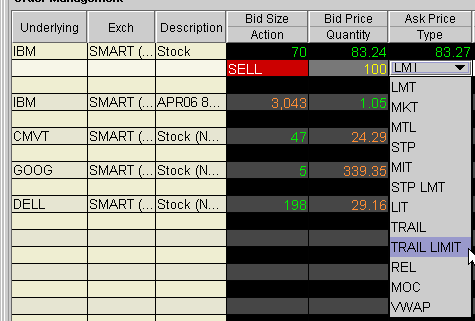Trailing Stop Limit Orders
A trailing stop limit order is designed to allow an investor to specify a limit on the maximum possible loss, without setting a limit on the maximum possible gain. A SELL trailing stop limit moves with the market price, and continually recalculates the stop trigger price at a fixed amount below the market price, based on the user-defined "trailing" amount. The limit order price is also continually recalculated based on the limit offset. As the market price rises, both the stop price and the limit price rise by the trail amount and limit offset respectively, but if the stock price falls, the stop price remains unchanged, and when the stop price is hit a limit order is submitted at the last calculated limit price. A "Buy" trailing stop limit order is the mirror image of a sell trailing stop limit, and is generally used in falling markets.
Trailing stop limits are available for all "Smart" routed stocks, options, and on all futures exchanges which currently support traditional stop orders.
In addition, IB offers adjustable trailing stop limit orders, which allow you to define a one-time change to the trailing amount or the limit price.
For information on how to create Trailing Stop Limit orders, please refer to the TWS User's Guide.
You're long 100 shares of XYZ with a current market price of $10.00. You set up a trailing stop limit sell order with these parameters:  |
Note: Any stock or option symbols displayed are for illustrative purposes only and are not intended to portray a recommendation.


